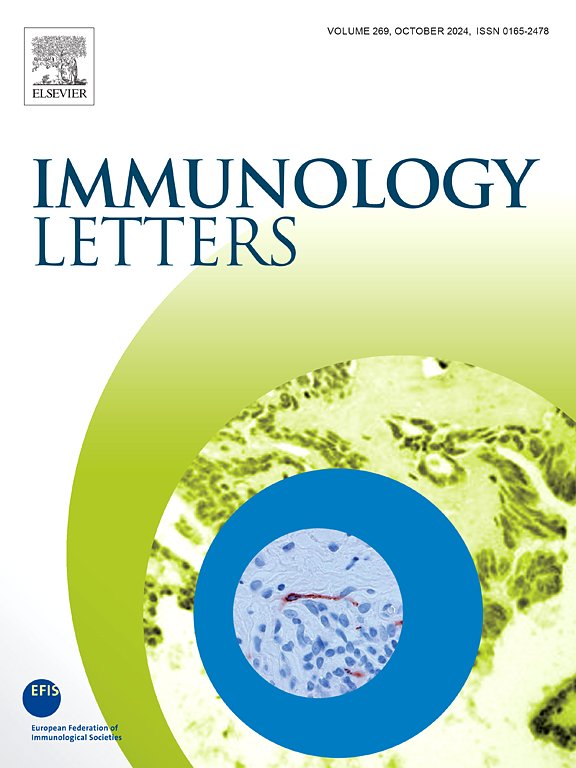Mast cell activation signature as a potential biomarker in COVID-19
IF 2.8
4区 医学
Q3 IMMUNOLOGY
引用次数: 0
Abstract
The COVID-19 pandemic, caused by the SARS-CoV-2 virus, represented a public health challenge due to the absence of effective treatments to combat the disease. Lethality associated with SARS-CoV-2 infection results from an exacerbated immune response that mediates clinical disease progression and compromises respiratory capacity and organ function. In the lungs, one of the cell lineages increased during COVID-19 are mast cells (MC), cells of innate immune response known for their ability to promote inflammation through the release of their pre-formed mediators or de novo synthesis. The role of MC-derived mediators during SARS-CoV-2 infection and their association with the development of severe COVID-19 have been poorly described. In a previous report, we demonstrated the predictive ability of carboxypeptidase A3 (CPA3) to determine COVID-19 severity. However, it is currently unclear whether the use of other mast cell-derived mediators could improve this predictive ability. To address this gap, we evaluated levels of total tryptase, CPA3, chymase, and prostaglandin D2 (PGD2) in serum from patients with non-severe and severe COVID-19 to develop a predictive model of severe COVID-19 outcomes. We demonstrate that the combined use of these mediators enhances their predictive ability for MC activation during SARS-CoV-2 infection and their involvement in severe forms of COVID-19. Based on these findings, a serum MC activation profile can be proposed as a promising biomarker for SARS-CoV-2 infection and may contribute to the development of targeted therapeutic strategies to improve patient outcomes.
肥大细胞激活特征作为COVID-19的潜在生物标志物
由SARS-CoV-2病毒引起的COVID-19大流行是一项公共卫生挑战,因为缺乏有效的治疗方法来对抗这种疾病。与SARS-CoV-2感染相关的致命性是由于免疫反应加剧,介导临床疾病进展,损害呼吸能力和器官功能。在肺部,在COVID-19期间增加的细胞系之一是肥大细胞(MC),这些细胞具有先天免疫反应,以其通过释放预形成的介质或从头合成来促进炎症的能力而闻名。mc衍生介质在SARS-CoV-2感染过程中的作用及其与严重COVID-19发展的关联尚未得到充分描述。在之前的报告中,我们证明了羧基肽酶A3 (CPA3)预测COVID-19严重程度的能力。然而,目前尚不清楚使用其他肥大细胞来源的介质是否可以提高这种预测能力。为了解决这一差距,我们评估了非严重和严重COVID-19患者血清中总胰蛋白酶、CPA3、酶切酶和前列腺素D2 (PGD2)的水平,以建立严重COVID-19结局的预测模型。我们证明,这些介质的联合使用增强了它们在SARS-CoV-2感染期间对MC激活的预测能力,以及它们参与严重形式的COVID-19的预测能力。基于这些发现,血清MC激活谱可以作为SARS-CoV-2感染的有希望的生物标志物,并可能有助于制定靶向治疗策略以改善患者预后。
本文章由计算机程序翻译,如有差异,请以英文原文为准。
求助全文
约1分钟内获得全文
求助全文
来源期刊

Immunology letters
医学-免疫学
CiteScore
7.60
自引率
0.00%
发文量
86
审稿时长
44 days
期刊介绍:
Immunology Letters provides a vehicle for the speedy publication of experimental papers, (mini)Reviews and Letters to the Editor addressing all aspects of molecular and cellular immunology. The essential criteria for publication will be clarity, experimental soundness and novelty. Results contradictory to current accepted thinking or ideas divergent from actual dogmas will be considered for publication provided that they are based on solid experimental findings.
Preference will be given to papers of immediate importance to other investigators, either by their experimental data, new ideas or new methodology. Scientific correspondence to the Editor-in-Chief related to the published papers may also be accepted provided that they are short and scientifically relevant to the papers mentioned, in order to provide a continuing forum for discussion.
 求助内容:
求助内容: 应助结果提醒方式:
应助结果提醒方式:


